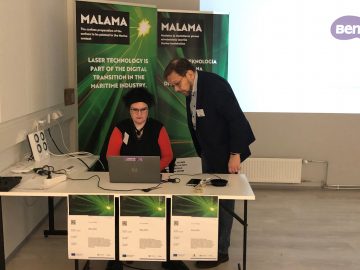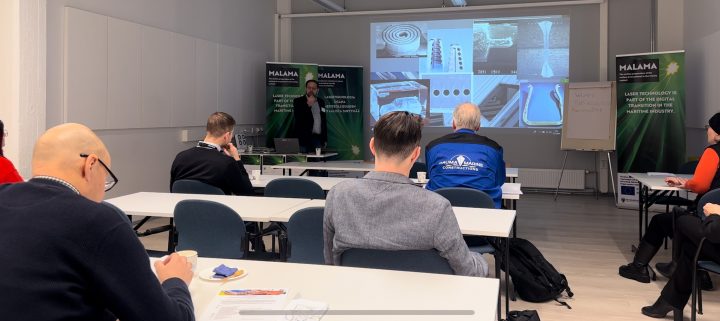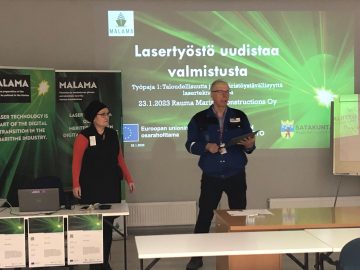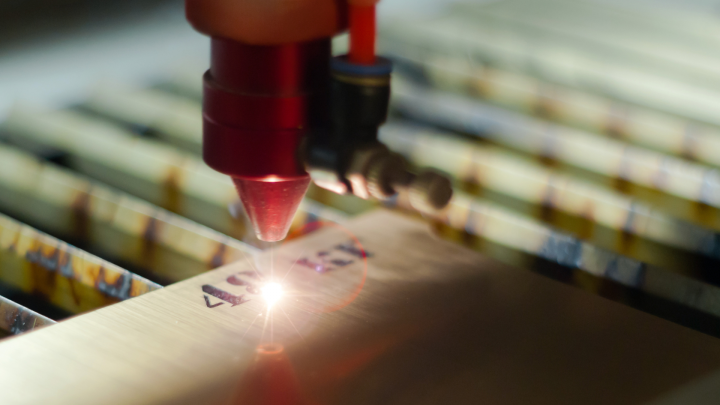”A solution looking for a problem”
”A solution looking for a problem” is how Theodore Mainman described the invention of the laser in the early 1960s. Long gone are those days. At the MALAMA workshop in Rauma in January, many examples were given as evidence of the development of laser technology and the role it can and could play in the maritime industry and other industrial sectors. A lively discussion took place with business representatives on the needs and wishes of companies, as well as brainstorming on possible new use areas for lasers. Next, these collected ideas will be tested using laser technology, first in laboratory conditions and then in an industrial environment. The first sprint will take place on 13 March in Turku, the second on 10 April in Rauma. Come and see laser machining in practice!

The MALAMA workshop was held under the theme ”Economy and sustainability through laser technology”. Experts and companies provided a comprehensive overview of the current state of laser technology and ideas on how to promote the use of laser processing for surface treatment, especially in the marine industry. Professor Antti Salminen from the Department of Mechanical Engineering at the University of Turku started the event by summarising what lasers are and how laser machining has modernised manufacturing. Adjunct Professor Heidi Piili from the same department took a deeper look into the world of lasers and explained what applications can be found around the world.
Markku Uusitalo, Project Manager of Rauma Marine Constructions, representing the host company, presented to the participants how laser machining has been used in shipbuilding and ”with hindsight” pointed out where laser machining could have been an advantage over more traditional methods in all past shipbuilding and refurbishment projects.
Laser processing is only limited by the imagination?
Laser processing is most commonly thought of as cutting or welding various types of sheet metal, but laser processing is used for a wide variety of applications. It can be used to clean, texture and polish different materials such as metal, plastic, ceramics or wood. It can be used to clean surfaces to be painted or weld steel, copper and even plastic. The technology can also be used to mark best-before dates on food packaging, computer keyboards or, for example, to make patterns on jeans.
The aerospace industry has long used laser processing to clean the painted surfaces of its aircraft. Salminen gave a practical example where the paint on an aircraft has to be removed every six years so as not to affect the base material. Laser technology is still in some cases a more expensive investment than traditional technologies, but it is faster and ultimately cheaper to treat aircraft paint surfaces with this technology than to keep the aircraft idle while the ”old” methods are used. However, the price of a surprising number of smaller lasers has fallen in recent years to a level where even smaller companies can invest in this technology.
The potential of laser technology seems limitless; it is truly a technology that continues to look for problems to solve.

Ideas for laser processing
In this phase of MALAMA, companies are involved in exploring different ideas for new uses of the technology. These will then be tested first in sprints, i.e. short experiments in laboratory conditions, and then in a more demanding environment in an industrial hall or even on board a ship. The main purpose of the workshop was to engage directly with interested maritime industry companies to localise these ideas. It was a great success! The workshop proved to be a fruitful brainstorming session, for which thanks must go to the active business representatives and the inspiring speakers. The discussions generated ideas for sprints on topics such as the removal of zinc coating from pipes, cleaning of welds, cleaning of concrete, joining of carbon fibre reinforced plastic and steel, and cleaning of rolled steel from rods using laser machining. The companies also promised to supply materials for future tests.
The safety aspects of using laser technology were also discussed at length during the brainstorming sessions. Experts stressed that when laser machining is used, the working space must be properly designed and the workers must be properly instructed and correctly protected. It is of the utmost importance to ensure that only equipment meeting safety requirements is used.
If your company has an idea that could be tested in a project, please feel free to contact us. The results of the project are public and open to the public.
MALAMA continues with sprints, i.e., short experiments. Make a note of the dates!

Next, the project will start sprints, first in laboratory conditions, then in an industrial environment. The sprints are open to all and will be held as follows:
MALAMA sprint 1: Rapid experimentation with laser technology in laboratory conditions (in Finnish)
13 March at 8:30-12:00, Machine Technology Center Turku Ltd, Turku. An advance registration is required at Registration Sprint 1
MALAMA sprint 2: Rapid experimentation with laser technology in an industrial environment (in Finnish)
10.4. at 8:30-14:00 Rauma Marine Constructions, Seaside Industry Park Rauma, Rauma. An advance registration is required at Registration Sprint 2
The MALAMA workshop was held in an inspiring environment at Seaside Industry Park Rauma on 23.1.2024. The workshop was hosted by Rauma Marine Constructions in cooperation with the project.
Kirsi Laitio
The MALAMA project is a project co-funded by the European Union and implemented by the Pori Unit of the Turku School of Economics (TSE Pori) and the Department of Mechanical and Materials Engineering of the University of Turku (project code A80056). The funding authority is the Regional Council of Satakunta from the EU Regional and Structural Policy Programme ”Innovation and Skills in Finland 2021–2027”.
